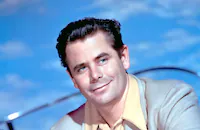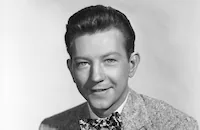Cry for Happy
Brief Synopsis
Cast & Crew
George Marshall
Glenn Ford
Donald O'connor
Miiko Taka
James Shigeta
Miyoshi Umeki
Film Details
Technical Specs

Synopsis
While recuperating in Japan after a Korean combat mission, four Navy photographers--Cyphers, Prince, Suzuki, and Lank--billet themselves in an off-limits geisha house they believe to be vacant. Though they discover four of the girls are still living there, their delight turns to disappointment when they learn that geishas are not exactly what they had imagined. Nevertheless, romance blossoms and the four men happily submit to a life of luxurious pampering. Then a tongue-in-cheek story Cyphers once told some newsmen--that he was fighting the Korean War to help Japanese orphans--gets considerable publicity in the States, and the Navy Department asks for details. The sailors and the geishas quickly borrow some neighbors' children and convert the geisha house into an orphanage. The hoax is a huge success, donations begin to pour in, and Cyphers is able to make the orphanage a reality. At a double wedding, Prince and Suzuki marry two of the girls, while Cyphers and Lank strongly consider following suit.

Director

George Marshall
Cast

Glenn Ford

Donald O'connor

Miiko Taka

James Shigeta

Miyoshi Umeki
Michi Kobi

Howard St. John
Joe Flynn
Chet Douglas
Tsuruko Kobayashi
Harriet Macgibbon
Robert Kino
Bob Okazaki

Harlan Warde
Nancy Kovack
Ted Knight
Bill Quinn
Chiyo Nakasone
Crew
Irving Brecher
Lambert Day
George Duning
Milton Feldman
William Goetz
William Goetz
Burnett Guffey
Robert F., (vice-adm. Usn, Ret.) Hickey
Walter Holscher
Helen Hunt
William Kiernan
Norma Koch
Ben Lane
Aki Mizuno
Arthur Morton
Charles J. Rice
Chester W. Schaeffer
United States--defense Department
United States--navy Department

Film Details
Technical Specs

Articles
Cry for Happy
Ford wasn't the only one revisiting the postwar Japanese theme and setting in Cry for Happy. Miiko Taka and Miyoshi Umeki, who played two of the geisha's, had their first big international successes with the drama Sayonara (1957), which also starred Marlon Brando, Ford's co-star in Teahouse. Umeki won a Best Supporting Actress Academy Award® for her role in the earlier film.
This was Ford's sixth teaming with director George Marshall and their fifth picture together in the short span of three years. Marshall had also directed Ford in one of his earliest films, Texas (1941). The two worked together again a few years later on another military-themed comedy (with a Civil War background), Advance to the Rear (1964); in fact, Ford played a service member four times under Marshall's direction. Marshall also directed an episode of Ford's TV series Cade's County in 1972.
Viewers may recognize the name of the cinematographer, Burnett Guffey, although Cry for Happy is certainly not one of the great pictures for which he will be remembered. That distinction goes to such films as his Academy Award® winners From Here to Eternity (1953) and Bonnie and Clyde (1967), as well as his collaborations with such directing legends as Max Ophuls, Robert Rossen, Nicholas Ray, and Fritz Lang.
Hawaiian-born actor James Shigeta, who plays American Navy man Suzuki, was for a time the top Asian-American actor in Hollywood and quite likely the most successful one of all time. The year prior to Cry for Happy he won the Most Promising Newcomer Golden Globe Award, based on his work in his first two movies, Samuel Fuller's The Crimson Kimono (1959) and James Clavell's Walk Like a Dragon (1960). After this, he went on to starring roles in Bridge to the Sun (1961) and the Rodgers and Hammerstein musical Flower Drum Song (1961), followed by a busy career in film and television that continues to this day.
Cry for Happy was shot partially on location in Japan and also aboard the USS Los Angeles docked in Long Beach, California.
Director: George Marshall
Producer: William Goetz
Screenplay: Irving Brecher, based on the novel by George Campbell
Cinematography: Burnett Guffey
Editing: Chester W. Schaeffer
Art Direction: Walter Holscher
Original Music: George Duning
Cast: Glenn Ford (Andy Cyphers), Donald O'Connor (Murray Prince), James Shigeta (Suzuki), Miyoshi Umeki (Harue), Miiko Taka (Chiyoko).
C-110m. Letterboxed.
by Rob Nixon

Cry for Happy
Donald O'Connor, 1925-2003
Born Donald David Dixon O' Connor in Chicago on August 28, 1925, he was raised in an atmosphere of show business. His parents were circus trapeze artists and later vaudeville entertainers, and as soon as young Donald was old enough to walk, he was performing in a variety of dance and stunt routines all across the country. Discovered by a film scout at age 11, he made his film debut with two of his brothers in Melody for Two (1937), and was singled out for a contract by Paramount Pictures. He co-starred with Bing Crosby and Fred MacMurray in Sing, You Sinners (1938) and played juvenile roles in several films, including Huckleberry Finn in Tom Sawyer - Detective (1938) and the title character as a child in Beau Geste (1939).
As O'Connor grew into adolescence, he fared pretty well as a youthful hoofer, dancing up a storm in a string of low-budget, but engaging musicals for Universal Studios (often teamed with the equally vigorous Peggy Ryan) during World War II. Titles like What's Cookin', Get Hep to Love (both 1942), Chip Off the Old Block and Strictly in the Groove (both 1943) made for some fairly innocuous entertainment, but they went a long way in displaying O'Connor's athletic dancing and boyish charm. As an adult, O'Connor struck paydirt again when he starred opposite a talking mule (with a voice supplied by Chill Wills) in the enormously popular Francis (1949). The story about an Army private who discovers that only he can communicate with a talking army mule, proved to be a very profitable hit with kids, and Universal went on to star him in several sequels.
Yet if O'Connor had to stake his claim to cinematic greatness, it would unquestionably be his daringly acrobatic, brazenly funny turn as Cosmo Brown, Gene Kelly's sidekick in the brilliant Singin' in the Rain (1952). Although his self-choreographed routine of "Make "Em Laugh" (which includes a mind-bending series of backflips off the walls) is often singled out as the highlight, in truth, his whole performance is one of the highlights of the film. His deft comic delivery of one-liners, crazy facial expressions (just watch him lampoon the diction teacher in the glorious "Moses Supposes" bit) and exhilarating dance moves (the opening "Fit As a Fiddle" number with Kelly to name just one) throughout the film are just sheer film treats in any critic's book.
After the success of Singin' in the Rain, O'Connor proved that he had enough charisma to command his first starring vehicle, opposite Debbie Reynolds, in the cute musical I Love Melvin (1953). He also found good parts in Call Me Madam (1953), There's No Business Like Show Business (1954), and Anything Goes (1956). Unfortunately, his one attempt at a strong dramatic role, the lead in the weak biopic The Buster Keaton Story (1957) proved to be misstep, and he was panned by the critics.
By the '60s, the popularity of musicals had faded, and O'Connor spent the next several years supporting himself with many dinner theater and nightclub appearances; but just when it looked like we wouldn't see O'Connor's talent shine again on the small or big screen, he found himself in demand at the dawn of the '90s in a string of TV appearances: Murder She Wrote, Tales From the Crypt, Fraser, The Nanny; and movies: Robin Williams' toy-manufacturer father in Toys (1992), a fellow passenger in the Lemmon-Matthau comedy, Out to Sea (1997), that were as welcoming as they were heartening. Survivors include his wife, Gloria; four children, Alicia, Donna, Fred and Kevin; and four grandchildren.
by Michael T. Toole
Donald O'Connor, 1925-2003
Quotes
Trivia
Notes
Location scenes filmed in Japan.

Miscellaneous Notes
Released in United States Spring March 1961
Film is a remake of 1956's "Teahouse of the August Moon"
Louis Calhern died of a heart attack in Tokyo during filming.
Ted Knight has a bit part in the film.
CinemaScope
Released in United States Spring March 1961













